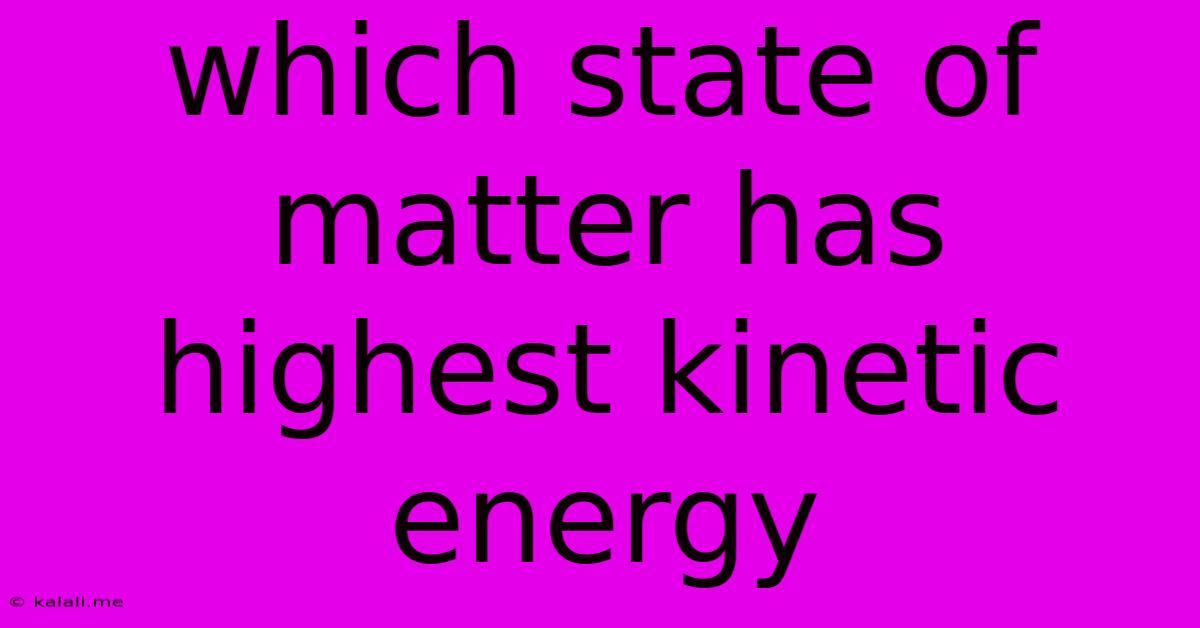Which State Of Matter Has Highest Kinetic Energy
Kalali
Jun 15, 2025 · 3 min read

Table of Contents
Which State of Matter Has the Highest Kinetic Energy? A Deep Dive into Kinetic Energy and States of Matter
Meta Description: Discover which state of matter boasts the highest kinetic energy. This article explores the relationship between kinetic energy, temperature, and the different states of matter – solid, liquid, gas, and plasma – explaining the science behind it.
The question of which state of matter possesses the highest kinetic energy isn't as straightforward as it might initially seem. While it's tempting to immediately jump to a conclusion, understanding the underlying principles of kinetic energy and the behavior of particles within different states is crucial. This article will delve into the intricacies of this topic, providing a clear and comprehensive answer.
Understanding Kinetic Energy
Kinetic energy is the energy an object possesses due to its motion. The faster an object moves, the higher its kinetic energy. At a microscopic level, this applies to the atoms and molecules that constitute matter. In substances, kinetic energy is directly related to temperature. Higher temperatures mean particles move faster, resulting in greater kinetic energy.
States of Matter and Particle Behavior
The different states of matter – solid, liquid, gas, and plasma – are characterized by the arrangement and movement of their constituent particles:
-
Solids: Particles in solids are tightly packed and vibrate in fixed positions. Their movement is restricted, resulting in relatively low kinetic energy.
-
Liquids: Particles in liquids are less tightly packed than in solids and can move around more freely. They possess higher kinetic energy than solids due to their increased mobility.
-
Gases: Particles in gases are widely dispersed and move rapidly and randomly. They exhibit much higher kinetic energy than solids or liquids because of their significant translational motion. Gas particles collide frequently with each other and the container walls.
-
Plasma: Plasma is often considered the fourth state of matter. It's a highly energized state where electrons are stripped from atoms, forming ions. Particles in plasma move at extremely high speeds, possessing the highest kinetic energy of all states of matter. This is due to the intense heat and electromagnetic forces involved in plasma formation.
The Answer: Plasma
Therefore, the state of matter with the highest kinetic energy is plasma. Its extremely high temperatures and the energetic movement of its constituent ions and electrons result in significantly greater kinetic energy compared to solids, liquids, and gases.
Factors Affecting Kinetic Energy
While temperature is the primary determinant of kinetic energy, other factors can influence it:
-
Mass of particles: Heavier particles at the same temperature will possess higher kinetic energy than lighter particles.
-
Intermolecular forces: The strength of forces between particles affects their movement and consequently their kinetic energy. Stronger intermolecular forces restrict movement, leading to lower kinetic energy.
Conclusion
In summary, understanding the relationship between kinetic energy and the states of matter requires considering the arrangement and movement of particles. While gases exhibit higher kinetic energy than solids and liquids due to the greater freedom of movement of their particles, plasma, with its highly energized and rapidly moving charged particles, holds the title of having the highest kinetic energy. This knowledge is fundamental to various scientific fields, including physics, chemistry, and materials science.
Latest Posts
Latest Posts
-
Which Of The Following Is An Example Of Prejudice
Jun 15, 2025
-
Which Of The Following Is Monosaccharide
Jun 15, 2025
-
Which Of The Following Are Pyrimidine Nitrogenous Bases
Jun 15, 2025
-
Least Common Multiple Of 45 And 15
Jun 15, 2025
-
Is 5 A Multiple Of 15
Jun 15, 2025
Related Post
Thank you for visiting our website which covers about Which State Of Matter Has Highest Kinetic Energy . We hope the information provided has been useful to you. Feel free to contact us if you have any questions or need further assistance. See you next time and don't miss to bookmark.